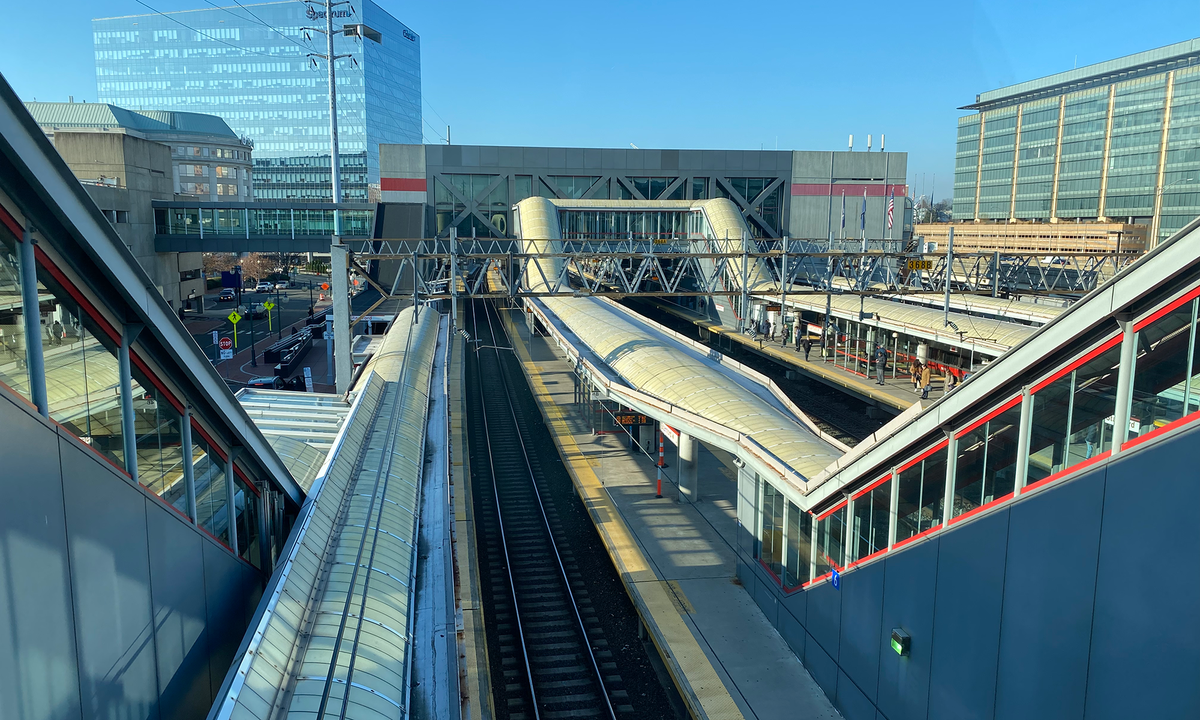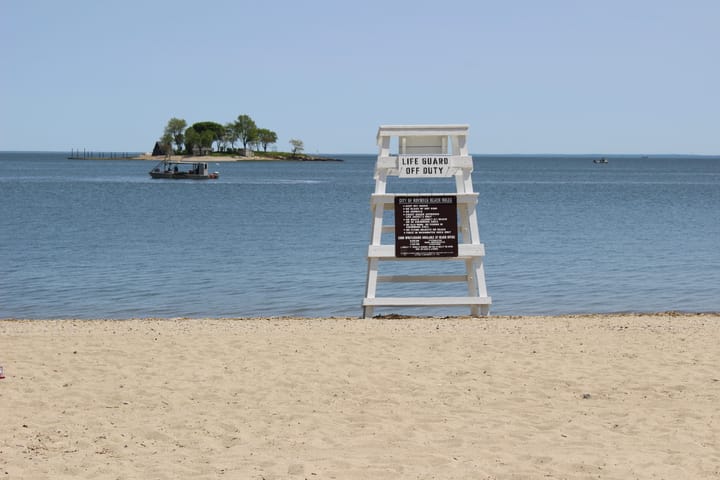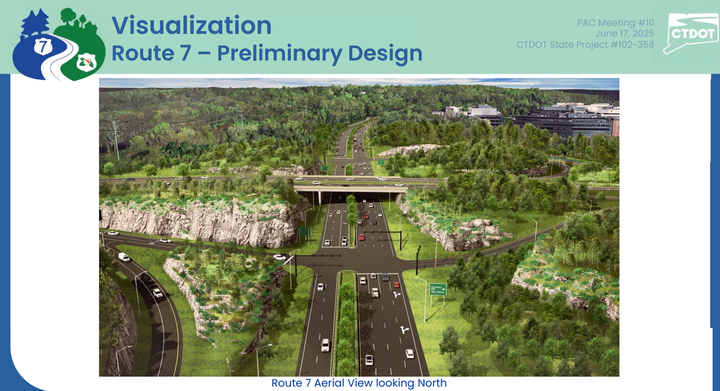Busiest Station in Southwest Connecticut: In and Around the Stamford Transportation Center
We take you inside the plans for the Stamford Transportation Center—and the area around it—in our next installment of our All Aboard series.

The “gateway to Connecticut” and the “second busiest train station after Grand Central” on the Northeast Corridor—that’s how Stamford Mayor Caroline Simmons described the Stamford Transportation Center.
It’s a major stop on Metro North’s New Haven line, offering both express and local service to and from both New York City and New Haven. Trains from the New Canaan branch and Danbury branch also make stops at the center, connecting riders across the region. The Stamford center is also the only Amtrak stop in southwest Connecticut, allowing riders to access Boston, Washington D.C., and more. And underneath the tracks, it’s the city’s hub for CTtransit buses.
The station had the most monthly tickets sold in 2023, according to the MTA, and ridership has been steadily returning to the pre-COVID-19 level of more than 28,000 daily riders.
That’s why the state and city have been investing—not just in the center itself, but in the area around it. Millions of dollars in local, state, and federal funding have already been spent, with more planned for local roads, infrastructure upgrades, and economic development projects around the station. And in 2022, the city rezoned the area around the station, which officials hoped would spur development in the area.
Let’s dive deeper into the work being done in and around the Stamford Transportation Center (STC) and what it means for Stamford—and the region as a whole.
Inside the Station
The Connecticut Department of Transportation is in the middle of developing a master plan for the station, in an effort to provide “a new vision of the STC that transforms the complex into a best-in-class facility,” according to Tony Sardilli, a project manager for VHB, which is the state’s consultant on the project.
“What is the STC master plan? A roadmap for the CTDOT to follow for transformative improvements for STC,” Sardilli said at a public meeting on the project in 2022, adding that the master plan “will be the basis for developing items,” such as budgets and capital plans.
The plan aims to examine and then propose renovations and upgrades for customer waiting areas, roads/sidewalks in and around the station, wayfinding to and in the center, bus and shuttle operations, parking, taxi and on-demand car service areas, and more.
Sardilli said that CTDOT is drawing inspiration from other stations around the country, including the Moynihan Train Hall in New York City and stations in Denver and Raleigh, North Carolina.
“We will develop recommendations aimed at creating a more engaging, convenient, safe, and aesthetically pleasing multimodal customer experience,” Sardilli said. “The recommendations will establish brand identity, identify measures to increase sustainability, promote the use of public transit, and enhance connectivity and integration between interior and exterior components.”
Right now, the state has developed two concepts for the transportation center, which residents provided feedback on last year. The state is currently incorporating the feedback into a final plan, the last step of the process.
The work to develop a plan for investment in the station comes at a time when the center had its fair share of challenges, including a partial ceiling collapse in the summer of 2023.
The state also is just finishing work on a new 928-space, 7-level parking garage on South State Street, which includes a 320-foot pedestrian bridge over Washington Boulevard connecting the garage to the center, 100 bike parking spaces, and some improvements to pedestrian access from the streets nearby.
According to CTDOT, “the purpose of the project is to replace the aging original parking garage structure for the STC (currently located on Station Place) with a low maintenance, long service life facility that meets the demand for State-owned commuter parking spaces located proximate to the STC.” The old garage will be demolished in the future, according to the state.
Better Connectivity to the Station
One of the biggest challenges that residents, commuters, and business owners in the area raised during the master planning public comment—as well as in the city’s public hearings on rezoning the area—was improving the local roads, sidewalks, and infrastructure around the station.
“I think it goes without saying that traffic in the area of the STC is an issue,” Sardilli said. “We’ve already heard that the existing pedestrian flow, both within the STC itself as well as the area around it, is not as friendly as it could be or as people want it to be.”
Simmons said that it was one of her “top priorities as mayor” to add trees, sidewalks, lighting, and bike lanes to the area in an effort to “make our streets safer, more accessible, and connected to the station.”
The master plan included different concepts for how the bike and pedestrian access to the station could be improved, including bike parking facilities and pedestrian plazas.
In addition to the concept improvements for access to the station itself, city transportation officials noted that there’s been major investments made to the roads around the station.
“It’s been hundreds and hundreds of millions of dollars in city, state, federal and private infrastructure investment in the South End and downtown areas,” Luke Buttenwieser, a transportation planner with the city told the Zoning Board in June 2022. “There’s not another place in the city or I would venture to say the state of Connecticut that’s received such high levels of transportation investment.”
Buttenwieser noted that “practically every single road and intersection has been upgraded” or is in the midst of being upgraded to support better connectivity to the station and future development in the area.
Some of those projects include:
- Atlantic Street bridge work
- Improvements to the Atlantic and Main Street intersection
- Pacific Street streetscape improvements
- Greenwich Avenue/Pulaski Street roundabout project
- The Dock Street connector road
Transit-Oriented Development
That future development could include more housing, commercial, and retail space to the area around the train station. In 2022, the Zoning Board voted to approve changing the zoning from mostly industrial uses to zones that would allow for mixed use developments, such as apartments with retail.
“This is a very accessible area,” Ralph Blessing, Stamford’s land use bureau chief, told the Zoning Board in June 2022. “A lot of the land is vacant and part of that has to do with the current zoning, because manufacturing is a use that is not very much sought after nowadays, so that’s really the rationale for changing the zoning to residential and commercial uses which are very much in demand.”
Blessing said that development in the area would help provide more housing options, as he noted the city and region are facing a “housing crisis and a housing shortage,”and also better tie together neighborhoods.
"This is sort of a no man’s land,” he said. “And development of this area around the train would connect the downtown and the South End much better.”
The approved zoning could allow for 1300 and 1400 units of housing around the train station, Blessing said.
The city broke the zoning up into three areas:
- Subarea A was rezoned to Transportation Center Designed District—which is aimed at “encouraging mixed-use development” near the center. This area includes I-95, the center itself, the state-owned parking garage, and the rail lines.
- Subarea B was rezoned to Transportation Center Designed District and includes areas between Atlantic and Pacific Street, and Blessing noted that this district has “a lot of vacant sites.”
- Subarea C was rezoned to Residential High Density, which allows for residential and community facilities. This area includes those properties east of Pacific Street. Blessing said that there’s “more office and commercial uses allowed” in the Transportation Center Designed District than this district, and the city wants “those closer to the train station.”
Buttenwieser said that this type of housing, located close to transit centers, helps to “reduce vehicle miles traveled.”
“How do we get people out of their cars and into transit?” he said to the Zoning Board. “The great part about the STC is that it has a very high level transit—very high levels of frequency, very high levels of service.”
Some development is already happening in the area, such as a 395-unit apartment building at 18 Dock Street, just a few blocks from the station, scheduled to open in the summer 2024.
He also said that the investments in the local roads were made in an effort to support more development in the area.
Questions about Density, Impact on City Services
Over three public hearings on the rezoning proposals, about 25 people spoke, with nine in favor and the remainder opposed.
Those who were in favor said that they believed the rezoning would help revitalize the area, provide more housing, and create walkable neighborhoods.
“The area around the train station is not being used to its fullest potential—it’s actually quite sad when you walk around there,” resident Dice Oh said. “We could have apartments, shopping centers, more mixed-use compact neighborhoods.”
Pastor David Washington of Little Zion Church of God in Christ at 73 Manhattan Street, part of the area that was rezoned, said that the Street has “become defunct,” which is why he said he was in favor of the rezoning.
“I believe that it would contribute to the vision of the South End,” he said at the June 2022 Zoning Board public hearing. “I see progress with the map change.”
Resident Jerry Silber said that by adding housing, it could also help cut down on emissions since those who work in the city might now have the opportunity to live there.
“If people can live here in town or work from, then they don't have to drive from other places,” he said.
Those who were opposed questioned the need for dense housing, raised concerns about traffic and congestion, and stated that they were concerned about the impact of more people on the city.
Resident Cynthia Bowser, who stated that she lived in the South End, said that she felt that “no one is listening” to the local residents.
“We were vehemently opposed to more density,” she said. “I'm not against development, I am against displacement. I am against gentrification.”
Resident Kathy Kligler said that she was concerned about the area “experiencing what Miami has experienced,” related to flooding and climate-related issues.
“Having access to the railroad station is a great idea, but I am not in favor of high density buildings in the area,” she said. “Stamford has really reached the end of being a mid-sized town, we’re starting to look like lower Manhattan.”
Stay Informed
Residents interested in following along with what’s happening in and around the Stamford Transit Center can keep an eye on these sites:
- Check out the STC Master Plan website for updates on the master plan work.
- See the city’s Transportation Department website to learn more about the transportation-related projects in the city.
- Visit the city’s Zoning Board webpage to keep track of proposed and active development projects.
This piece is part of our All Aboard series, which aims to explore the train stations (and the areas around them) across southwest Connecticut and their impact on the region.



